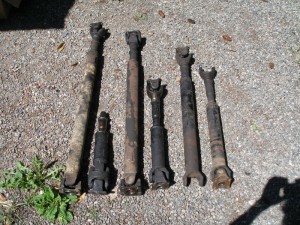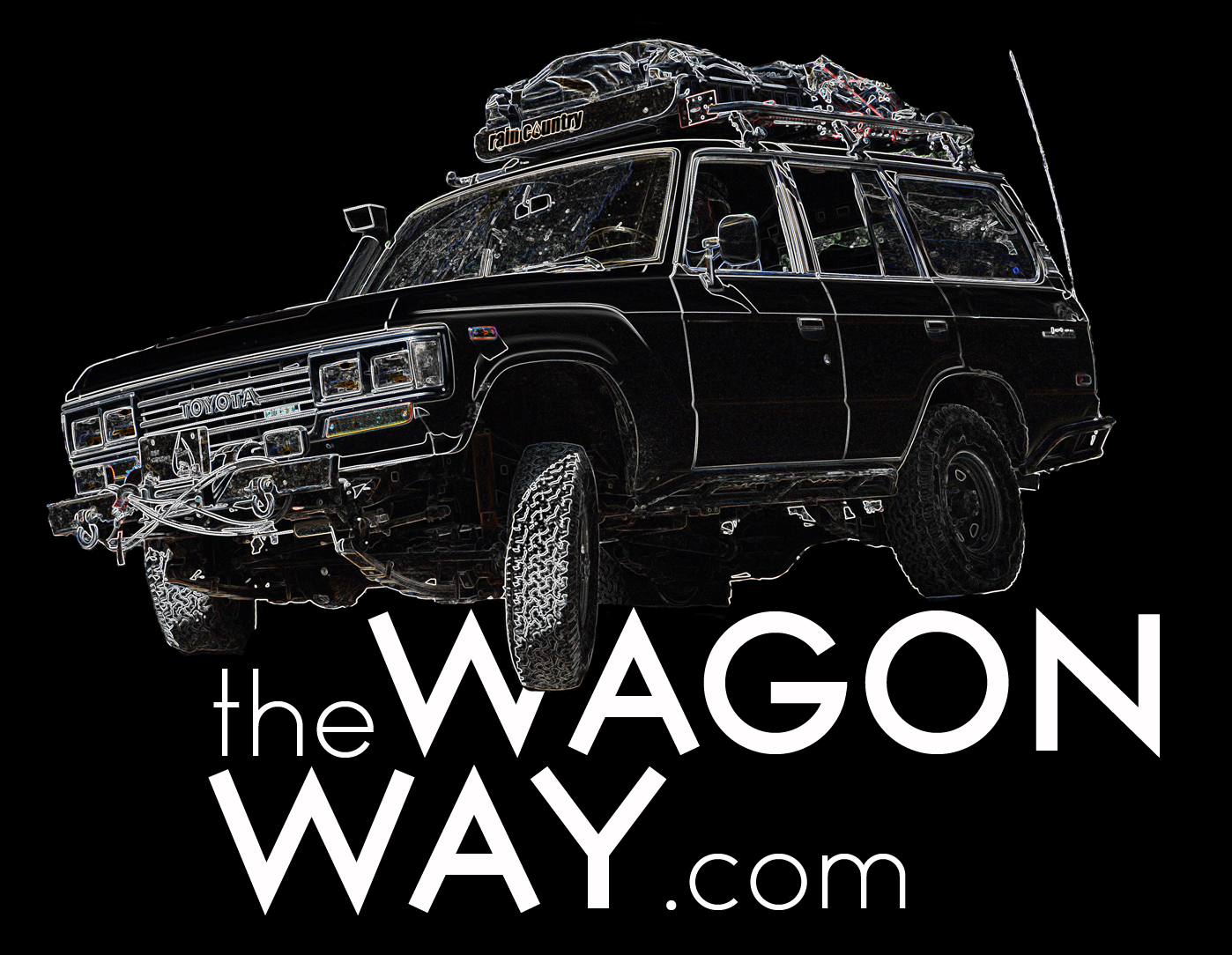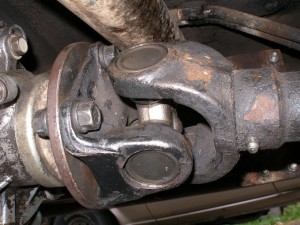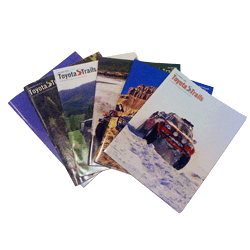By Tony K
 A fairly simple component of our rigs but there are some things you should know. But first a little explanation of the two types of driveshafts you will find on a 60 is in order. Keep in mind the point of this article is to give you some know how about the two types of driveshafts not provide all the answers as there is a lot more to learn about.
A fairly simple component of our rigs but there are some things you should know. But first a little explanation of the two types of driveshafts you will find on a 60 is in order. Keep in mind the point of this article is to give you some know how about the two types of driveshafts not provide all the answers as there is a lot more to learn about.
Double Carden or Single U-joint?
The most common driveshafts in our wagons is the simple slip yoke design, one u-joint at each end. The other option found on early wagons is a double carden design on the front shaft. This design has a joint at the t-case made up of two u-joints and a center pivot. The center pivot is there to split the angle of the shaft evenly between the two u-joints and facilitates more even wear.
Proper Set Up
There are numerous parts involved and they are all spinning. And putting them together correctly makes sure they spin properly. In phase is a term you will come across and it just may be the most often misunderstood problem on our rigs when it comes to the drivetrain. Having everything in phase helps prevent vibration. Most people think lining up the u-joints is all it takes to be in phase and this is only part of the equation. The other part of the equation is the relationship between the t-case and the differential. And being that there are two types of driveshafts this relationship can be drastically different.
In theory, the ideal set up for the more common single u-joint, the differential and the transmission are parallel to each other. They do not have to be on the same level but they should be on the same plane. If you take a look under your rig you will notice the engine, t-case and tranny are tipped back a bit and the rear diff is rotated up to match this angle. This way the angles on each end of the installed driveshaft are the same.
And this angle should be in the ideal range. The number I have heard is somewhere between 3 and 7 Degrees. Not that you frequently don’t go beyond and below this but running outside of this range for extended periods can lead to premature wear of your u-joints. And heavy loads at the limit of driveline angles can also lead to sudden and catastrophic failure.
Double Carden
Double Carden set ups are a whole different ball game. Essentially the differential is in line with the driveshaft. This means the diff has been rotated up to line up with the installed angle of the driveshaft. Or in simpler terms, the centerline of the pinion points at the output shaft of the t-case. This way any differences in the angle of the t-case, in relation to the driveshaft, is accounted for by the Double Carden. Mostly these are in rigs with really short driveshafts or on rigs that need to run pretty severe angles. More of a problem with short wheelbase rigs than our wagons. The short length of the front driveshaft on early 60’s was the reason these models were fitted with Double cardens.
So what’s this mean for your rig?
Depends a lot on how you use your rig. A rig driven a lot at highway speeds needs more attention paid to the driveshaft set up than a pure trail rig. As a trail rig can get away with driveshaft angles that wouldn’t be the least bit acceptable on the highway. I have one friend who actually runs square tube driveshafts on his rock buggy…. The slip yoke on his are simply the front part of the shaft being a smaller tube that slides in the larger.
A 60 can be lifted about 2-3″ without having to make changes to the driveshafts. Putting a lift kit in a rig will not change the relationship of the t-case and tranny if it has been set up for the typical single u-joint style of driveshaft. All you are changing is the working angle of the u-joints. As long as the lift is not too extreme you won’t have to change anything. A more severe lift may take your driveshaft working angles beyond the ideal, but other angles do work as many guys can attest to.
But you should know what angles your rig is running after you change the suspension out. So it’s time to get out a protractor or angle finder. What you really need to know is the relationship between the driveshaft and the flanges on the t-case and pinion. Ideally they should be within a couple of degrees of each other. What you also should know is the angle when the suspension is at full droop so you can be certain you are not exceeding the max working angle of the u-joints, if it exceeds this you need to limit the down travel of the suspension. Full compression angles would be nice to know as well but compressing the leaf spring pack without the weight of the rig is going to be a little tough. But generally compression is considerably less than droop so for our wagons it’s generally not an issue.
Do I Need to Change Driveshafts?
There are some good indicators whether you need to rethink your driveshafts. Lots of driveline vibration or frequent replacement of u-joints is probably the two best indicators. Both of these are telling you something that you need to pay attention to.
If your lift puts you beyond practical working angles you may need to think about a Double Carden shaft as you can’t fix this with angled wedges on the spring perches. It will mess up the geometry of the whole package with next to no gain. But the switch to a Double Carden is not just a simple parts swap.
To set up a rig for a double carden is a very different story. The angle of the pinion has to be inline with the driveshaft (within a couple of degrees) for a Double Carden to function the best. This can be done with simple shims on the rear axle but doing this on the front axle is not an option as it will mess with the steering geometry.
It takes a much more drastic solution to make sure your steering geometry is correct if you put a large lift on your rig and want (or need) to change to a Double Carden driveshaft. The only way to put the steering geometry back to factory specs is called a cut and turn. This involves cutting the ends off your front axle, rotating the housing the appropriate amount and welding it back together. Not easily done by the home shop guy or even recommended for you to try. Leave this one to the shops that have experience doing cut and turns. You also need to be aware that rotating the pinion up (in both the front and rear) will lower the oil level at the fill plug so you may need to change this as well.
Bottom Line
Do your homework and research before you go out and spend a ton of money on half a fix. Driveshafts are part of a complete package, be sure what package is under your rig first. And my first stop would be the link at the end of this write up as Tom Wood will teach you more about the subject than you want to know (but really should know)
Making Things Work
It is very important to line up the yokes on the driveshafts. Remember this when you pull apart your driveshaft for maintenance, if you seperate the slip yoke you need to reinstall it so the u-joints are in the same orientation. It’s best to mark the shaft before you take it apart.
Keep things well lubed but not over-lubed. I have heard horror stories about too much grease in slip yokes causing a hydraulic lock and things coming apart in a dramatic fashion. Not what I want to happen on a trail run.
Damage
There are some things to look for on your driveshafts that just may prevent you from getting stuck in the woods. The easiest one is sloppy u-joints, no amount of movement is good. Keep them lubed and replace them when they got loose. Sometimes its worth pulling the shaft to see if they still move like they should. I once found that both u-joints on my rear driveshaft were shot due to rust and corrosion. The u-joints would not easily pivot and there were no outward signs of problems, just the grease didn’t get to where it needed to go.
Dents in the driveshaft tube are definately a problem, sudden failure is on the horizon if you don’t change it out.
Speaking of fixing things. I am a firm believer in doing everything I can when it comes to my rig, but welding a new tube in is better left to the driveline shop if it is going to be used on the road. They have a lot more equipment than a welder, including the stuff to re-balance a shaft. On the other hand if it is for off road use only, not a big deal and I do have a back up front shaft that I put together just for this purpose.
More Info
The absolute best place to learn about driveshafts that I have come across is actually one of the well known names in driveshafts. Tom Wood’s Driveshafts. He has a tech page that really lays out driveshaft know how. If you need more info I would definately go to their page http://www.4xshaft.com/index.html. This site cleared up a lot of what I thought I knew and they cover much more than I have.


